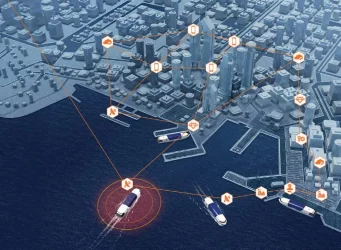
KEY DISTINCTION BETWEEN SMART SHIPS AND DIGITAL TWINS
In layman’s language, a Smart Ship is a vessel embedded with a large number of sensors linked with AI and Big Data for the collection and analysis of all possible data about the vessel, at rest and during the voyage. Whereas a Digital Twin is a virtual copy of the vessel generated in an off-shore office for conducting simulations and obtaining real-time and future data of the vessel, thereby enabling the shipping company to choose the best course of action.
While a Smart Ship relies on various IoT-based sensors attached to the ship for monitoring and analyzing the vessel in real-time and does not focus on running algorithm-based simulations. The Digital Twins rely on the IoT-based sensors on the ship to create a virtual image of the vessel for the sole purpose of running simulations and providing future forecasts.
Smart Ships focus on AI-based real-time data sharing of the vessel, thereby allowing real-time analysis and optimization, whereas Digital Twins rely on past and present data to analyze and optimize the vessel’s working even before the voyage begins.
Smart Ships use big data analysis for real-time strategic decision-making for all the stakeholders. In contrast, Digital Twins use big data analysis to influence real-time and future decisions based on billions of possible circumstances.
Smart Ships are less expensive and less technologically advanced, specifically when it comes to making strategic decisions, compared to Digital Twins. On the other hand, Digital Twins are more expensive, technologically advanced, and offer accurate predictions based on the available data compared to Smart Ships.
WHAT DOES THE FUTURE HOLD?
With China Shipbuilding Industry Corporation (CSIC) launching the Unmanned Freighter Project and Japan launching the Smart Ship Application Platform Project, the world is moving towards making the dream of Smart Ships a reality. The European Union has initiated the Maritime Unmanned Navigation Through Intelligence in Networks (MUNIN) project to build and develop a fully unmanned automated vessel by 2035. Similarly, Rolls Royce led, Advanced Autonomous Waterborne Applications (AAWA), is set to achieve the goal of autonomous ships by 2035. Globally renowned companies, such as DNV-GL, INTENS, MPA Shipping, SINTEF etc., have dedicated time and resources to develop Digital Twin in the maritime industry.
The digital and technological revolution has largely led the maritime industry to focus on technology-based automation in the shipping industry. The world which has already seen self-driving vehicles and unmanned spacecraft will soon see unmanned artificially intelligent ships sailing in the open sea. A simulated environment created by Digital Twins coupled with Smart Ship technology is no doubt the future of a safe, efficient, and progressing Maritime Industry.